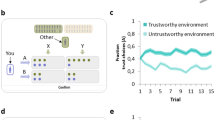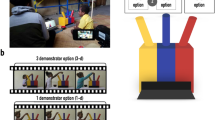Abstract
New behavioural and neuroscientific evidence on the development of fairness behaviours demonstrates that the signatures of human fairness can be traced into childhood. Children make sacrifices for fairness (1) when they have less than others, (2) when others have been unfair and (3) when they have more than others. The latter two responses mark a critical departure from what is observed in other species because they enable fairness to be upheld even when doing so goes against self-interest. This new work can be fruitfully combined with insights from cognitive neuroscience to understand the mechanisms of developmental change.
This is a preview of subscription content, access via your institution
Access options
Access Nature and 54 other Nature Portfolio journals
Get Nature+, our best-value online-access subscription
$29.99 / 30 days
cancel any time
Subscribe to this journal
Receive 12 digital issues and online access to articles
$119.00 per year
only $9.92 per issue
Buy this article
- Purchase on Springer Link
- Instant access to full article PDF
Prices may be subject to local taxes which are calculated during checkout




Similar content being viewed by others
References
Tinbergen, N. On aims and methods of ethology. Z. Tierpsychol. 20, 410–433 (1963).
Bateson, P. & Laland, K. N. Tinbergen's four questions: an appreciation and an update. Trends Ecol. Evol. 28, 712–718 (2013).
West-Eberhard, M. J. Developmental Plasticity and Evolution (Oxford Univ. Press, 2003).
Aristotle. The Nicomachean Ethics (Harvard Univ. Press, 1999).
Rawls, J. A Theory of Justice (Harvard Univ. Press, 1971).
Adams, J. S. Inequity in social exchange. Adv. Exp. Soc. Psychol. 2, 267–299 (1965).
Deutsch, M. Equity, equality, and need: what determines which value will be used as the basis of distributive justice? J. Soc. Issues 31, 137–149 (1975).
Loewenstein, G. F., Thompson, L. & Bazerman, M. H. Social utility and decision making in interpersonal contexts. J. Pers. Soc. Psychol. 57, 426–441 (1989).
Dawes, C. T., Fowler, J. H., Johnson, T., McElreath, R. & Smirnov, O. Egalitarian motives in humans. Nature 446, 794–796 (2007).
Camerer, C. Behavioral Game Theory: Experiments in Strategic Interaction (Princeton Univ. Press, 2003).
Fehr, E. & Schmidt, K. M. A theory of fairness, competition, and cooperation. Q. J. Econ. 114, 817–868 (1999).
Güth, W., Schmittberger, R. & Schwarze, B. An experimental analysis of ultimatum bargaining. J. Econ. Behav. Organ. 3, 367–388 (1982).
Henrich, J. et al. “Economic man” in cross-cultural perspective: behavioral experiments in 15 small-scale societies. Behav. Brain Sci. 28, 795–815 (2005).
Fehr, E. & Fischbacher, U. Third-party punishment and social norms. Evol. Hum. Behav. 25, 63–87 (2004).
Henrich, J. et al. Costly punishment across human societies. Science 312, 1767–1770 (2006).
Brosnan, S. F. & de Waal, F. B. M. Evolution of responses to (un)fairness. Science 346, 1251776 (2014).
Bräuer, J. & Hanus, D. Fairness in non-human primates?. Soc. Just. Res. 25, 256–276 (2012).
McAuliffe, K. & Santos, L. R. in The Atlas of Moral Psychology: Mapping Good and Evil in the Mind (eds. Gray, K. & Graham, J. ) (Guilford Press, in the press).
Jensen, K., Call, J. & Tomasello, M. Chimpanzees are rational maximizers in an ultimatum game. Science 318, 107–109 (2007).
Proctor, D., Williamson, R. A., de Waal, F. B. M. & Brosnan, S. F. Chimpanzees play the ultimatum game. Proc. Natl Acad. Sci. USA 110, 2070–2075 (2013).
Riedl, K., Jensen, K., Call, J. & Tomasello, M. No third-party punishment in chimpanzees. Proc. Natl Acad. Sci. USA 109, 14824–14829 (2012).
Fehr, E.,& Fischbacher, U. Social norms and human cooperation. Trends Cogn. Sci. 8, 185–190 (2004)
Geraci, A. & Surian, L. The developmental roots of fairness: infants' reactions to equal and unequal distributions of resources. Dev. Sci. 14, 1012–1020 (2011).
Schmidt, M. F. H. & Sommerville, J. A. Fairness expectations and altruistic sharing in 15-month-old human infants. PLoS ONE 6, 1–7 (2011).
Sloane, S., Baillargeon, R. & Premack, D. Do infants have a sense of fairness?. Psychol. Sci. 23, 196–204 (2012).
Smith, C. E., Blake, P. R. & Harris, P. L. I should but I won't: why young children endorse norms of fair sharing but do not follow them. PLoS ONE 8, e59510 (2013).
LoBue, V., Nishida, T., Chiong, C., DeLoache, J. S. & Haidt, J. When getting something good is bad: even three-year-olds react to inequality. Soc. Dev. 20, 154–170 (2010).
Blake, P. R. & McAuliffe, K. I had so much it didn't seem fair: eight-year-olds reject two forms of inequity. Cognition 120, 215–224 (2011).
Fehr, E., Bernhard, H. & Rockenbach, B. Egalitarianism in young children. Nature 454, 1079–1083 (2008).
Shaw, A., Choshen-Hillel, S., & Caruso, E. The development of inequity aversion: understanding when (and why) people give others the bigger piece of the pie. Psychol. Sci. 27, 1352–1359 (2016).
Chernyak, N., & Kushnir, T. Giving preschoolers choice increases sharing behavior. Psychol. Sci. 24, 1971–1979 (2013).
McAuliffe, K., Blake, P. R., Kim, G., Wrangham, R. W. & Warneken, F. Social influences on inequity aversion in children. PLoS ONE 8, e80966 (2013).
McAuliffe, K., Blake, P. R. & Warneken, F. Children reject inequity out of spite. Biol. Lett. 10, 20140743 (2014).
Blake, P. R., McAuliffe, K., Corbit, J., Callaghan, T. C. & Barry, O. The ontogeny of fairness in seven societies. Nature 528, 258–261 (2015).
Wittig, M., Jensen, K. & Tomasello, M. Five-year-olds understand fair as equal in a mini-ultimatum game. J. Exp. Child Psychol. 116, 324–337 (2013).
Lucas, M. M., Wagner, L. & Chow, C. Fair game: the intuitive economics of resource exchange in four-year olds. J. Soc. Evol. Cult. Psychol. 2, 74–88 (2008).
Bereby-Meyer, Y. & Fiks, S. Changes in negative reciprocity as a function of age. J. Behav. Decis. Making 26, 397–403 (2013).
Gummerum, M. & Chu, M. T. Outcomes and intentions in children's, adolescents', and adults' second- and third-party punishment behavior. Cognition 133, 97–103 (2014).
Sutter, M. Outcomes versus intentions: on the nature of fair behavior and its development with age. J. Econ. Psychol. 28, 69–78 (2007).
Sally, D. & Hill, E. The development of interpersonal strategy: autism, theory-of-mind, cooperation and fairness. J. Econ. Psychol. 27, 73–97 (2006).
Castelli, I., Massaro, D., Sanfey, A. G. & Marchetti, A. Fairness and intentionality in children's decision-making. Int. Rev. Econ. 57, 269–288 (2010).
Castelli, I., Massaro, D., Bicchieri, C., Chavez, A. & Marchetti, A. Fairness norms and theory of mind in an ultimatum game: judgments, offers, and decisions in school-aged children. PLoS ONE 9, e105024 (2014).
Harbaugh, W., Krause, K. & Liday, S. J. Bargaining by children. Preprint at http://dx.doi.org/10.2139/ssrn.436504 (2003).
Steinbeis, N., Bernhardt, B. C. & Singer, T. Impulse control and underlying functions of the left DLPFC mediate age-related and age-independent individual differences in strategic social behavior. Neuron 73, 1040–1051 (2012).
Güroğlu, B., van den Bos, W. & Crone, E. A. Fairness considerations: increasing understanding of intentionality during adolescence. J. Exp. Child Psychol. 104, 398–409 (2009).
Hamlin, J. K. & Wynn, K. Young infants prefer prosocial to antisocial others. Cogn. Dev. 26, 30–39 (2011).
Hamlin, J. K., Wynn, K., Bloom, P. & Mahajan, N. How infants and toddlers react to antisocial others. Proc. Natl Acad. Sci. USA 108, 19931–19936 (2011).
McAuliffe, K., Jordan, J. J. & Warneken, F. Costly third-party punishment in young children. Cognition 134, 1–10 (2015).
Salali, G. D., Juda, M. & Henrich, J. Transmission and development of costly punishment in children. Evol. Hum. Behav. 36, 86–94 (2015).
Jordan, J. J., McAuliffe, K. & Warneken, F. Development of in-group favoritism in children's third-party punishment of selfishness. Proc. Natl Acad. Sci. USA 111, 12710–12715 (2014).
Sheskin, M., Bloom, P. & Wynn, K. Anti-equality: social comparison in young children. Cognition 130, 152–156 (2014).
Shaw, A. & Olson, K. R. Children discard a resource to avoid inequity. J. Exp. Psychol. Gen. 141, 382–395 (2012).
Munakata, Y., Snyder, H. R. & Chatham, C. H. Developing cognitive control: three key transitions. Curr. Dir. Psychol. Sci. 21, 71–77 (2012).
Zelazo, P. D. et al. II. NIH Toolbox Cognition Battery (CB): measuring executive function and attention. Monogr. Soc. Res. Child Dev. 78, 16–33 (2013).
Fehr, E. & Camerer, C. F. Social neuroeconomics: the neural circuitry of social preferences. Trends Cogn. Sci. 11, 419–427 (2007).
Feng, C. et al. Diffusion of responsibility attenuates altruistic punishment: a functional magnetic resonance imaging effective connectivity study. Hum. Brain Mapp. 37, 663–677 (2016).
Gabay, A. S., Radua, J., Kempton, M. J. & Mehta, M. A. The Ultimatum Game and the brain: a meta-analysis of neuroimaging studies. Neurosci. Biobehav. Rev. 47, 549–558 (2014).
Ruff, C. C. & Fehr, E. The neurobiology of rewards and values in social decision making. Nat. Rev. Neurosci. 15, 549–562 (2014).
Steinbeis, N. & Singer, T. The effects of social comparison on social emotions and behavior during childhood: the ontogeny of envy and Schadenfreude predicts developmental changes in equity-related decisions. J. Exp. Child Psychol. 115, 198–209 (2013).
Phelps, E. A. Emotion and cognition: insights from studies of the human amygdala. Annu. Rev. Psychol. 57, 27–53 (2006).
Barrett, L. F., Bliss-Moreau, E., Duncan, S. L., Rauch, S. L. & Wright, C. I. The amygdala and the experience of affect. Soc. Cogn. Affect. Neurosci. 2, 73–83 (2007).
Feinstein, J. S., Adolphs, R., Damasio, A. & Tranel, D. The human amygdala and the induction and experience of fear. Curr. Biol. 21, 34–38 (2011).
Yu, R., Calder, A. J. & Mobbs, D. Overlapping and distinct representations of advantageous and disadvantageous inequality. Hum. Brain Mapp. 35, 3290–3301 (2014).
Sanfey, A. G., Rilling, J. K., Aronson, J. A., Nystrom, L. E. & Cohen, J. D. The neural basis of economic decision-making in the Ultimatum Game. Science 300, 1755–1758 (2003).
Baumgartner, T., Knoch, D., Hotz, P., Eisenegger, C. & Fehr, E. Dorsolateral and ventromedial prefrontal cortex orchestrate normative choice. Nat. Neurosci. 14, 1468–1474 (2011).
Güroğlu, B., van den Bos, W., Rombouts, S. A. R. B. & Crone, E. A. Unfair? It depends: neural correlates of fairness in social context. Soc. Cogn. Affect. Neurosci. 5, 414–423 (2010).
Corradi-Dell'Acqua, C., Civai, C., Rumiati, R. I. & Fink, G. R. Disentangling self- and fairness-related neural mechanisms involved in the Ultimatum Game: an fMRI study. Soc. Cogn. Affect. Neurosci. 8, 424–431 (2013).
Civai, C., Crescentini, C., Rustichini, A. & Rumiati, R. I. Equality versus self-interest in the brain: differential roles of anterior insula and medial prefrontal cortex. NeuroImage 62, 102–112 (2012).
Zhong, S., Chark, R., Hsu, M. & Chew, S. H. Computational substrates of social norm enforcement by unaffected third parties. NeuroImage 129, 95–104 (2016).
Carter, C., Van Veen, V., Botvinick, M., Cohen, J. & Stenger, V. A. Conflict and the evaluative functions of the anterior cingulate: converging evidence from event-related fMRI and high density ERP. NeuroImage 13, S305–S305 (2001).
Knoch, D., Pascual-Leone, A., Meyer, K., Treyer, V. & Fehr, E. Diminishing reciprocal fairness by disrupting the right prefrontal cortex. Science 314, 829–832 (2006).
van't Wout, M., Kahn, R. S., Sanfey, A. G. & Aleman, A. Repetitive transcranial magnetic stimulation over the right dorsolateral prefrontal cortex affects strategic decision-making. Neuroreport 16, 1849–1852 (2005).
de Quervain, D. et al. The neural basis of altruistic punishment. Science 305, 1254–1258 (2004).
Ruff, C. C., Ugazio, G. & Fehr, E. Changing social norm compliance with noninvasive brain stimulation. Science 342, 482–484 (2013).
Spitzer, M., Fischbacher, U., Herrnberger, B., Grön, G. & Fehr, E. The neural signature of social norm compliance. Neuron 56, 185–196 (2007).
Buckholtz, J. W. & Marois, R. The roots of modern justice: cognitive and neural foundations of social norms and their enforcement. Nat. Neurosci. 15, 655–661 (2012).
Buckholtz, J. W. et al. From blame to punishment: disrupting prefrontal cortex activity reveals norm enforcement mechanisms. Neuron 87, 1369–1380 (2015).
Blake, P. R., Piovesan, M., Montinari, N. & Warneken, F. Prosocial norms in the classroom: the role of self-regulation in following norms of giving. J. Econ. Behav. Organ. 115, 18–29 (2015).
Steinbeis, N. & Crone, E. A. The link between cognitive control and decision-making across child and adolescent development. Curr. Opin. Behav. Sci. 10, 28–32 (2016).
Lamm, C., Decety, J. & Singer, T. Meta-analytic evidence for common and distinct neural networks associated with directly experienced pain and empathy for pain. NeuroImage 54, 2492–2502 (2011).
Dawes, C. T. et al. Neural basis of egalitarian behavior. Proc. Natl Acad. Sci. USA 109, 6479–6483 (2012).
Corradi-Dell'Acqua, C., Tusche, A., Vuilleumier, P. & Singer, T. Cross-modal representations of first-hand and vicarious pain, disgust and fairness in insular and cingulate cortex. Nat. Commun. 7, 10904 (2016).
Grocke, P., Rossano, F. & Tomasello, M. Procedural justice in children: preschoolers accept unequal resource distributions if the procedure provides equal opportunities. J. Exp. Child Psychol. 140, 197–210 (2015).
Smith, C. E. & Warneken, F. Children's reasoning about distributive and retributive justice across development. Dev. Psychol. 52, 613–628 (2016).
Shaw, A. et al. Children develop a veil of fairness. J. Exp. Psychol. Gen. 143, 363–375 (2014).
Takagishi, H., Kameshima, S., Schug, J., Koizumi, M. & Yamagishi, T. Theory of mind enhances preference for fairness. J. Exp. Child Psychol. 105, 130–137 (2010).
Kanngiesser, P. & Warneken, F. Young children consider merit when sharing resources with others. PLoS ONE 7, e43979 (2012).
Knoch, D. et al. Disrupting the prefrontal cortex diminishes the human ability to build a good reputation. Proc. Natl Acad. Sci. USA 106, 20895–20899 (2009).
Saxe, R. & Kanwisher, N. People thinking about thinking people. The role of the temporo-parietal junction in ‘theory of mind’. NeuroImage 19, 1835–1842 (2003).
Baumgartner, T., Schiller, B., Rieskamp, J., Gianotti, L. R. R. & Knoch, D. Diminishing parochialism in intergroup conflict by disrupting the right temporo-parietal junction. Soc. Cogn. Affect. Neurosci. 9, 653–660 (2014).
Thompson, C., Barresi, J. & Moore, C. The development of future-oriented prudence and altruism in preschoolers. Cogn. Dev. 12, 199–212 (1997).
Gogtay, N. et al. Dynamic mapping of human cortical development during childhood through early adulthood. Proc. Natl Acad. Sci. USA 101, 8174–8179 (2004).
Shaw, P. et al. Intellectual ability and cortical development in children and adolescents. Nature 440, 676–679 (2006).
Sowell, E. R. Longitudinal mapping of cortical thickness and brain growth in normal children. J. Neurosci. 24, 8223–8231 (2004).
Lebel, C. & Beaulieu, C. Longitudinal development of human brain wiring continues from childhood into adulthood. J. Neurosci. 31, 10937–10947 (2011).
Power, J. D., Fair, D. A., Schlaggar, B. L. & Petersen, S. E. The development of human functional brain networks. Neuron 67, 735–748 (2010).
Zielinski, B. A., Gennatas, E. D., Zhou, J. & Seeley W. W. Network-level structural covariance in the developing brain. Proc. Natl Acad. Sci. USA 107, 18191–18196 (2010).
Kelly, A. M. C. et al. Development of anterior cingulate functional connectivity from late childhood to early adulthood. Cereb. Cortex 19, 640–657 (2009).
Fair, D. A. et al. Development of distinct control networks through segregation and integration. Proc. Natl Acad. Sci. USA 104, 13507–13512 (2007).
Supekar, K., Musen, M. & Menon, V. Development of large-scale functional brain networks in children. PLoS Biol. 7, e1000157 (2009).
Uddin, L. Q., Supekar, K. S., Ryali, S. & Menon, V. Dynamic reconfiguration of structural and functional connectivity across core neurocognitive brain networks with development. J. Neurosci. 31, 18578–18589 (2011).
Luna, B., Marek, S., Larsen, B., Tervo-Clemmens, B. & Chahal, R. An integrative model of the maturation of cognitive control. Annu. Rev. Neurosci. 38, 151–170 (2015).
Marek, S., Hwang, K., Foran, W., Hallquist, M. N. & Luna, B. The contribution of network organization and integration to the development of cognitive control. PLoS Biol. 13, e1002328 (2015).
Acknowledgements
The authors would like to thank J. Greene, B. Güroğlu, D. Knoch, L. Somerville, and L. Young for their feedback on this review. N.S. is supported by an Early Career Research Fellowship from the Jacobs Foundation. F.W. is supported by an NSF CAREER grant.
Author information
Authors and Affiliations
Corresponding author
Ethics declarations
Competing interests
The authors declare no competing interests.
Rights and permissions
About this article
Cite this article
McAuliffe, K., Blake, P., Steinbeis, N. et al. The developmental foundations of human fairness. Nat Hum Behav 1, 0042 (2017). https://doi.org/10.1038/s41562-016-0042
Received:
Accepted:
Published:
DOI: https://doi.org/10.1038/s41562-016-0042
This article is cited by
-
Trusting young children to help causes them to cheat less
Nature Human Behaviour (2024)
-
Self-serving bias in fairness perception: Allowing allocators to allocate unfairly
Current Psychology (2024)
-
Beyond behavior: the penitence congruity effect among children
Current Psychology (2024)
-
Children perpetuate competence-based inequality when they help peers
npj Science of Learning (2023)
-
The cognitive challenges of cooperation in human and nonhuman animals
Nature Reviews Psychology (2023)



